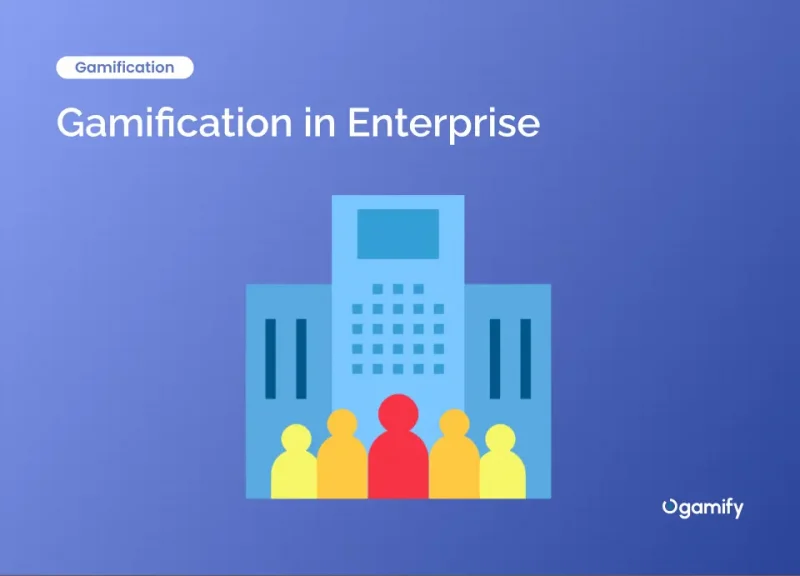In the dynamic and competitive business landscape, companies are continually searching for innovative ways to boost their employees’ productivity and drive better results. Enterprise gamification has emerged as a powerful and effective approach that leverages game mechanics and principles to motivate employees, enhance learning, and achieve business objectives. By incorporating elements of play and competition into everyday tasks and processes, gamification transforms the workplace into an engaging and rewarding environment, ultimately leading to increased performance and satisfaction.

What is Enterprise Gamification?
Enterprise gamification is the strategic implementation of game elements, such as points, badges, leaderboards, and rewards, into the work environment to encourage desired behaviors, foster healthy competition, and recognize employees’ achievements. It draws inspiration from the engaging and motivational aspects of games, tapping into people’s natural inclination towards challenges and rewards.
In practical terms, enterprise gamification can take various forms, from employee training and development programs to project management, sales incentives, and even customer loyalty programs. It aims to make work more enjoyable and meaningful, driving employees to perform at their best while maintaining a positive and collaborative atmosphere.

How can Gamification be Used in Enterprises?
Gamification offers a versatile and impactful approach to drive employee engagement and achieve various business objectives within enterprises. Here are additional examples of how gamification can be applied across different areas, including event planning:
- Sales and Customer Service: Implementing gamification in sales and customer service teams can boost performance and customer satisfaction. By setting up leaderboards, rewarding top performers, and recognizing outstanding customer service, employees are motivated to excel in their roles.
- Employee Onboarding and Training: Gamification can enhance the onboarding process for new hires. By incorporating interactive quizzes, simulations, and challenges, employees quickly grasp essential information about the company, leading to a smoother and more engaging onboarding experience.
- Productivity and Time Management: Gamification can be used to encourage time management and productivity. Employees can earn rewards for completing tasks within set deadlines or efficiently managing their schedules, promoting a more efficient and focused workforce.
- Innovation and Idea Generation: Companies can leverage gamification to crowdsource ideas and innovation. Creating platforms where employees can submit and vote on ideas fosters a culture of innovation and empowers employees to contribute to the organization’s growth.
- Health and Wellness Programs: Gamification can promote employee well-being through fitness challenges, step-count competitions, or wellness quizzes. These initiatives encourage healthier lifestyles and can lead to reduced absenteeism and increased productivity.
- Quality Assurance and Compliance: Gamification can ensure adherence to quality standards and compliance regulations. Employees can earn points or rewards for following safety protocols or maintaining quality control measures, ensuring consistent performance.
- Project Management: Gamification can aid project management by assigning points for completing project milestones, adhering to budgets, or meeting deadlines. This approach fosters a sense of achievement and progress, driving teams to deliver successful projects.
- Learning and Skill Development: Beyond onboarding, gamification can be integrated into ongoing training programs. Employees can earn badges or level up as they acquire new skills and complete different training modules, fostering continuous learning.
- Employee Recognition and Rewards: Gamification can facilitate peer-to-peer recognition and rewards, allowing employees to nominate and appreciate each other’s contributions. This boosts morale, reinforces positive behavior, and strengthens team dynamics.
- Social Collaboration and Knowledge Sharing: Gamification can encourage knowledge sharing and collaboration among employees. Employees can gain points or rewards for sharing valuable insights, participating in discussions, or contributing to shared knowledge platforms, promoting a culture of continuous improvement.
- Event Planning: Gamification can transform the event planning process into an engaging and interactive experience. By integrating gamified elements into the planning platform, employees can earn points or badges for suggesting event themes, coordinating with vendors, and promoting the event on social media. This encourages active participation and teamwork, leading to successful and memorable events.
By incorporating gamification into these diverse areas, enterprises can create a more engaging and motivated workforce, leading to increased productivity, improved employee satisfaction, and overall organizational success. Gamification’s flexibility allows it to be customized to suit specific business needs and challenges, making it a powerful tool for driving positive change within an organization.

What are the Benefits of Using Gamification in Enterprise?
The adoption of gamification within enterprises offers numerous benefits that positively impact both employees and the organization as a whole:
- Enhanced Employee Engagement: Gamification injects elements of fun and competition into daily tasks, transforming them into enjoyable experiences. As a result, employees become more engaged, motivated, and eager to participate in their work.
- Improved Learning and Development: Training and development programs often suffer from low engagement and retention rates. Gamification can revitalize these programs by incorporating interactive elements such as quizzes, challenges, and progress tracking. Employees are more likely to retain knowledge and skills when learning becomes an enjoyable and rewarding process.
- Foster Team Collaboration: Gamification can encourage teamwork and collaboration among employees. By participating in challenges together and achieving shared goals, employees build stronger bonds and communication skills, fostering a more cohesive and efficient workforce.
- Goal Achievement and Performance: The clear goals and rewards in gamification drive employees to strive for excellence. By recognizing and celebrating achievements, gamification motivates employees to consistently perform at their best, leading to higher productivity and better results for the organization.
- Real-time Performance Tracking: Gamification platforms often provide real-time analytics, enabling managers to track employee performance and identify areas for improvement. This data-driven approach allows for quicker and more informed decision-making in talent management and employee development.

Conclusion
Enterprise gamification represents a revolutionary approach to motivate employees, boost productivity, and achieve business goals. By tapping into people’s natural desire for challenges and rewards, gamification transforms routine tasks into enjoyable experiences, fostering a more engaged and productive workforce.
Whether it’s event planning, training programs, or talent management, the implementation of gamification holds tremendous potential for driving positive change within an organization. Embracing the principles of gamification allows enterprises to unlock the full potential of their employees, creating a culture of excellence and continuous improvement.
FAQ
Is gamification suitable for all types of enterprises?
Yes, gamification can be adapted to suit the specific needs and goals of various enterprises, regardless of their size or industry. It is a versatile approach that can be applied in diverse scenarios.
Can gamification replace traditional training methods entirely?
While gamification enhances learning, it is best used as a complementary tool alongside traditional training methods to achieve optimal results. Combining both approaches can create a comprehensive and effective learning experience.
How do gamification platforms measure success?
Gamification platforms use data analytics and performance tracking to measure the success of various gamification initiatives. They analyze engagement levels, completion rates, and other relevant metrics to evaluate the effectiveness of the gamified elements.
Can gamification improve employee retention rates?
Yes, by creating a more engaging and rewarding work environment, gamification can have a positive impact on employee satisfaction and retention rates. Employees who feel valued and recognized are more likely to stay with the company.
What makes GamiPro stand out among other gamification platforms?
GamiPro’s extensive customization options and user-friendly interface make it an ideal choice for enterprises seeking a tailored gamification solution. Its analytics capabilities also provide valuable insights, allowing organizations to fine-tune their gamification strategies for optimal results.

